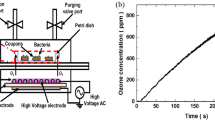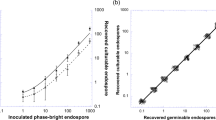Summary
Biological indicators (BIs) are used to monitor ethylene oxide (EO) gas sterilization processes for medical devices. Several European and United States BIs for EO sterilization were evaluated for resistance according to both United States Pharmacopeia (USP) XXI and United Kingdom's (UK) tests for D-values. US BIs areB. subtilis var. niger spores on paper strips or disc carriers while European BIs use aluminum strips, quartz sand, or cotton yarn. Numerous BIs per run and runs per lot, as well as 2–3 different lots of BIs from each manufacturer, were examined. Both British and US BIs met their respective label claims for rates of inactivation when tested against British and USP EO test parameters, respectively. However, Danish BIs, on cotton yarn or quartz sand, were not inactivated following USP specifications during the exposure dwell times tested (600 mg L−1 EO, 54°C, 60% RH, 0–110 min). The Danish BIs will require further testing in order for us to determine if theirB. subtilis spores are unusually resistant to EO or if the spore carrier substrates protect the spores from the sterilizing gas. In conclusion, the British and American BIs for EO sterilization are equivalent in resistance despite differences in carrier substrate, recovery conditions, calculation methods for D-values, and the labeled sterilization conditions for use.
Similar content being viewed by others
References
Association of Official Analytical Chemists. 1984. In: Official Methods of Analysis, 14th edn, Sect. 46.013(m), p. 942, Arlington, VA.
Caputo, R.A. and T.E. Odlaug. 1983. Sterilization with ethylene oxide and other gases. In: Disinfection, Sterilization, and Preservation (Block, S.S., ed.), Ch. 2, Lea and Febiger, Philadelphia PA.
Dadd, A.H. and G.M. Daley. 1990. Resistance of microorganisms to inactivation by gaseous ethylene oxide. J. Appl. Bacteriol. 49: 89–101.
Department of Health and Social Security (DHSS). 1985. Specification for biological monitors for the control of ethylene oxide sterilization. Specification No. TSS/S/330.012, London, UK.
Glasstone, S. and D. Lewis. 1960. Kinetics of chemical reactions. In: Elements of Physical Chemistry, pp. 601–608, D. Van Nostrand Company, Princeton, NJ.
Pflug, I.J. 1982. Analysis of survival data. In: Introductory Course in the Microbiology and Engineering of Sterilization Processes, 5th edn, pp. 7.1–7.44, Environmental Sterilization Laboratory, Minneapolis, MN.
United States Pharmacopeia. 1985. Biological indicators for ethylene oxide sterilization, paper strip, pp. 119–120, 21st Rev., Mack Printing Company, Easton, PA.
Author information
Authors and Affiliations
Rights and permissions
About this article
Cite this article
Demitrius, C.A., Duran, A.P., Chamberlain, V.C. et al. Comparison of European and US biological indicators for ethylene oxide sterilization. Journal of Industrial Microbiology 12, 399–402 (1993). https://doi.org/10.1007/BF01569671
Issue Date:
DOI: https://doi.org/10.1007/BF01569671




